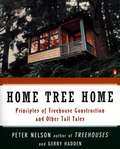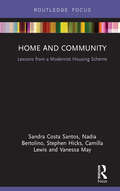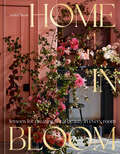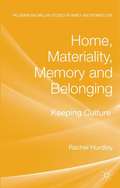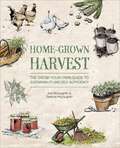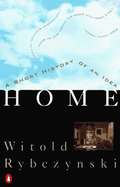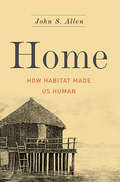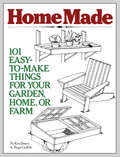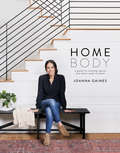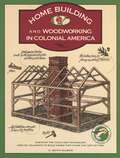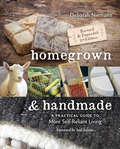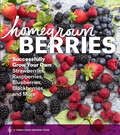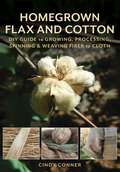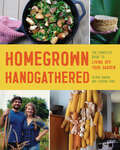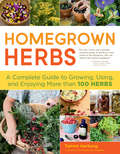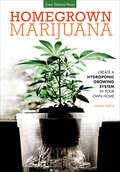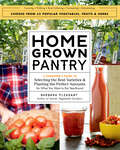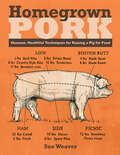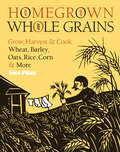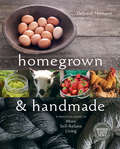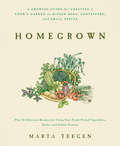- Table View
- List View
Home Thoughts from the Heart
by Mary KennedyA sense of home, and of love, is what makes life meaningful for me. I invite you to share in a journey through family, friendship and adventure in the pages of this book, and hope that you will find something here that resonates with you. After all, we're all walking this road through life together -- and that's what makes it worthwhile.Love, MaryIcon of Irish broadcasting Mary Kennedy invites us into her world in this beautiful book of words and pictures, sharing stories from her life at home and abroad, along with favourite recipes that have been handed down the generations. From family weddings and gatherings, and her love of gardening, to the ups and downs of life, and finding meaning in the spiritual, Mary describes her inner world with an intimacy and honesty her readers have come to love.Including musings on the challenges -- and benefits -- of getting older, and how life can make you stumble when you least expect it (just so you can experience what it is to rise again!), Home Thoughts from the Heart is a book to be cherished.*Please note that this is an illustrated book and therefore is best viewed on optimal devices*
Home Tree Home
by Peter N. Nelson Gerry HaddenRemember the view from atop a tree? You could survey the landscape like a monarch, escape your parents' watchful eye, and let your imagination run wild. Well, just because you've grown up, it doesn't mean you can't enjoy the sense of liberation a tree provides. Here is the most comprehensive guide ever to building your own castle in the air, be it a simple child's playhouse or an adult's cozy retreat with all the modern conveniences, including electricty. Peter Nelson, the nation's foremost authority on treehouses, tells you everything you need to know about designing and building the house that's right for you and your family. He gives you information on site selection (why some trees provide better homes than others), safety issues, tree care, advice on styles and materials, and other essential rules of thumb that will save time and money. Nelson walks you through the construction of four actual projects: a children's playhouse, a vacation home, an office, and a full-time residence. Whether you'd like to build your children a safe and fun place to play and dream, or you're contemplating your own retreat from the drudgeries of earthbound living, this practical, wildly fanciful guide will show you how to make your tree fantasies come true.
Home and Community: Lessons from a Modernist Housing Scheme
by Vanessa May Stephen Hicks Camilla Lewis Sandra Costa Santos Nadia BertolinoExamining the relationships between architecture, home and community in the Claremont Court housing scheme in Edinburgh, Home and Community provides a novel perspective on the enabling potential of architecture that encompasses physical, spatial, relational and temporal phenomena. Based on the AHRC funded project "Place and Belonging", the chapters draw on innovative spatial layouts amid Scottish policymakers' concerns of social change in the 1960s, to develop theoretical understandings between architecture, home, and community. By approaching the discourse on home, and by positioning the home at the confluence of a network of sociocultural identities bound by spatial awareness and design, the writers draw on sociological interpretations of cultural negotiation as well as theoretical underpinnings in architectural design. In so doing, they suggest a reinterpretation of the facilitating role of architecture as sensitive to physical and socio-cultural reconstruction. Drawn from interviews with residents, architectural surveys, contextual mapping and other visual methods, Home and Community explores home as a construct that is enmeshed with the architectural affordances that the housing scheme represents, that is useful to both architecture and sociology students, as well as practitioners and urban planners.
Home from the Hardware Store: Transform Everyday Materials into Fabulous Home Furnishings
by Kathleen Hackett Stephen Antonson50 stylish projects from the aisles of the home improvement centerIn Home from the Hardware Store, artist and designer Stephen Antonson and his wife, Kathleen Hackett ply the aisles of the home improvement center and emerge with a host of ideas for clever, original decorative objects any interior designer would love. Antonson and Hackett cast their eyes on pedestrian materials—drain covers, cork matting, plumbing parts, light sockets, brass nails—and see lamps, wallpaper, table runners, side tables, even cuff links. Organized by decorating challenge, chapters include ideas for lighting, windows and walls, furniture, tabletop, and storage. Beautiful full-color photos, including how-to pictures along with clear, concise, yet friendly instructions, accompany every project. Sidebars and quick tips are scattered throughout, providing DIYers with gentle reminders and instructions for basic tool and equipment use. Design lovers, crafters, and penny pinchers alike will find much to inspire in Home from the Hardware Store.
Home in Bloom: Lessons for Creating Floral Beauty in Every Room
by Ariella ChezarA vivid, inspiring look at the role of flowers and plants in interior design through the stunning, wild work of Ariella Chezar.Home in Bloom celebrates the seamless integration of architecture, light, and natural landscapes into Ariella Chezar's floral designs. Her talent for layering colors and combining improbable wild elements results in arrangements that are as gorgeous as they are dynamic. With each page, Ariella invites us to revel in the inherent drama of nature, encouraging us to infuse our living spaces with beauty and abundance, while fundamentally altering a room's energy through the transformative power of flowers.Organized into chapters that celebrate every room in the home—Welcome, Nourish, Celebrate, Pause, and Wilding—Home in Bloom takes us on a journey through spaces filled with incredible blooms that spark color and light. The arrangements in each chapter are accompanied by detailed captions that inspire us to walk outside and bring the wilds of nature into our own spaces. Filled with hundreds of gorgeous photographs of inviting spaces, this interior design book is full of unique inspiration for any flower lover.
Home with Rue: Style for Everyone [An Interior Design Book]
by Kelli LambFrom top home design magazine Rue comes an accessible guide to creating your ideal space.&“Home with Rue tells us, step by step, how we can feel confident about making home design choices that make every room in our house gorgeous.&”—Bobbi Brown, founder of Jones Road Beauty and creative director of The George hotel No matter your location, your style, or your budget, beautiful design should be available to all. As a pioneer in the digital magazine industry, Rue has inspired thousands since establishing their business in 2010. Now Rue&’s editorial director, Kelli Lamb, has created this incredible collection to carry their style and advice into book form.Home with Rue is a compendium of inspirational and accessible ideas to help anyone imagine, plan, and create their ultimate living space. Written in the signature Rue voice and full of beautiful images of real homes lived in by real people, it features thoughtfully curated advice, how-to information, and resources. Each chapter focuses on a different space and explores a variety of complementary aesthetics. Woven throughout are expert insights, concise tips and tricks sharing why certain decorating methods work, and quotes from top designers on their creative processes and favorite details or memories of a space. With hundreds of never-before-seen interior design photographs from Rue's extensive collection, Home with Rue is destined to be a timeless classic to help fans, followers, and readers design the rooms and home of their dreams.
Home, Materiality, Memory and Belonging: Keeping Culture
by Rachel HurdleyAssembling Mass Observation Archive material with historiographies of family, house and nation from ancient-Greece to present-day Europe, China and America, this book contributes to current debates on identity, belonging, memory and material culture by exploring how power works in the small spaces of home.
Home-Ec 101: Skills for Everyday Living
by Heather Solos Jacqueline MusserReal Skills for Real Life From keeping your home clean and in good repair to preparing your own food, self-sufficiency rocks. Having an understanding of the domestic arts gives you a sense of control over your life. These skills also help you save money, not by chasing deals, but by teaching the principle of the mantra: Use it up, wear it out, make it do, or do without. Life skills are the essence of frugality. Whether you just moved out of your parent's basement or you cut the apron strings a while ago, you'll learn the skills you need to manage your household. Inside you'll find: Quick, easy cleaning solutions for every room of the house, so you can get the job done and get on with life Instructions for removing stubborn stains and offensive odors from fabric Simple fixes to wardrobe malfunctions including broken zippers, missing buttons, and fallen hemlines Troubleshooting advice for common problems with home appliances A minimum home maintenance guide to prevent or catch major repair problems A basic plumbing tutorial that includes clearing and preventing clogs, stopping a running toilet and retrieving items dropped down a drain Ideas for healthy and fast meal planning so you can start cooking and stop relying on takeout or preservative-packed convenience food Definitions of common cooking terms and techniques found in recipes Plans for stocking a pantry so you can make dinner (even if you haven't been grocery shopping in a week) and be prepared when disaster strikes A complete rundown of essential kitchen equipment from knives to pans to small appliances Equip yourself with the skills you need for everyday life.
Home-Grown Harvest: The Grow-Your-Own Guide to Sustainability and Self-Sufficiency
by Terence McLaughlin Eve McLaughlinGrow your way to happiness with Home-Grown Harvest, the practical handbook for a more sustainable life. Whether you have a large country garden or a small backyard in the city, this essential guide to the &‘Good Life&’ will help you on your journey to becoming more self-sufficient – which is something we all need to be thinking about. Climate change, industrial farming with its reliance on chemicals, rising food prices, fears over food security or just a desire to spend more time outdoors – there are many reasons driving people towards homegrown food and self-sufficiency. Growing your own fruit and vegetables, preserving your produce and generating your own energy are all covered in this thrifty guide by the original &‘Tom and Barbara&’, Eve and Terence McLaughlin, who wrote the first edition of this book in 1979. This information-packed book has expert advice on growing, harvesting, storing and preserving your produce. You can brew your own beer and learn how to bottle, cure, smoke and pickle your produce to make it last longer. The book features easy-to-follow instructions for DIY tools and equipment to save money, reduce energy consumption and cut back on waste. Learn how to plan your site, explore the best planting times and methods, discover how to grow a variety of vegetables, fruit and nuts, and how to deal with pests and diseases. As well as growing your own food, the book also covers the basics of keeping livestock – including chickens, ducks, goats and pigs – and how to harness alternative energy sources such as solar and wind power. Putting your own food on the table and playing your part in creating a more sustainable future is hugely rewarding and also has health benefits – the physical exercise of planting and harvesting, the mental wellness that comes with spending time in nature, and the reduction in chemicals in the food you eat – there is so much in this activity that fosters greater wellbeing. Whether you&’re planning a move to full-blown self-sufficiency or are just curious about what&’s involved and want to take your first steps to growing your own food, this essential guide has everything you need to know.
Home: A Short History of an Idea
by Witold Rybczynski<p>Walk through five centuries of homes both great and small--from the smoke-filled manor halls of the Middle Ages to today's Ralph Lauren-designed environments--on a house tour like no other, one that delightfully explicates the very idea of "home." <p>You'll see how social and cultural changes influenced styles of decoration and furnishing, learn the connection between wall-hung religious tapestries and wall-to-wall carpeting, discover how some of our most welcome luxuries were born of architectural necessity, and much more. Most of all, Home opens a rare window into our private lives--and how we really want to live.</p>
Home: How Habitat Made Us Human
by John S. AllenHome is where the heart is. Security, comfort, even love, are all feelings that are centered on the humble abode. But what if there is more to the feeling of being at home? Neuroanthropologist John S. Allen believes that the human habitat is one of the most important products of human cognitive, technological, and cultural evolution over the past two million years. In Home, Allen argues that to "feel at home" is more than just an expression, but reflects a deep-seated cognitive basis for the human desire to have, use, and enjoy a place of one's own. Allen addresses the very basic question: How did a place to sleep become a home? Within human evolution, he ranks house and home as a signature development of our species, as it emerged alongside cooperative hunting, language, and other critical aspects of humanity. Many animals burrow, making permanent home bases, but primates, generally speaking, do not: most wander, making nests at night wherever they might find themselves. This is often in home territory, but it isn't quite home. Our hominid ancestors were wanderers, too--so how did we, over the past several million years, find our way home? To tell that story Allen will take us through evolutionary anthropology, neuroscience, the study of emotion, and modern sociology. He examines the home from the inside (of our heads) out: homes are built with our brains as much as with our hands and tools. Allen argues that the thing that may have been most critical in our evolution is not the physical aspect of a home, but developing a feeling of defining, creating, and being in a home, whatever its physical form. The result was an environment, relatively secure against whatever horrors lurked outside, that enabled the expensive but creative human mind to reach its full flowering. Today, with the threat of homelessness, child foster-care, and foreclosure, this idea of having a home is more powerful than ever. In a clear and accessible writing style, Allen sheds light on the deep, cognitive sources of the pleasures of having a home, the evolution of those behaviors, and why the deep reasons why they matter. Home is the story about how humans evolved to create a space not only for shelter, but also for nurturing creativity, innovation, and culture--and why "feeling at home" is a fundamental aspect of the human condition.
HomeMade: 101 Easy-to-Make Things for Your Garden, Home, or Farm
by Ken Braren Roger GriffithDiscover the satisfaction of building your own lawn chairs, fences, bootjacks, cold frames, and compost bins. <P><P>Ken Braren and Roger Griffith show you how to build a variety of easy-to-make items for your home and garden that are designed to save you money and make your life easier. <P><P>Even if you have limited construction experience, the simple instructions and clear illustrations in this guide will have you confidently crafting your own potting bench and building a basement closet.
Homebody: A Guide to Creating Spaces You Never Want to Leave
by Joanna GainesIn Homebody: A Guide to Creating Spaces You Never Want to Leave, Joanna Gaines walks you through how to create a home that reflects the personalities and stories of the people who live there. Using examples from her own farmhouse as well as a range of other homes, this comprehensive guide will help you assess your priorities and instincts, as well as your likes and dislikes, with practical steps for navigating and embracing your authentic design style. Room by room, Homebody gives you an in-depth look at how these styles are implemented as well as how to blend the looks you're drawn to in order to create spaces that feel distinctly yours. A design template at the end of the book offers a step-by-step guide to planning and sketching out your own design plans. The insight shared in Homebody will instill in you the confidence to thoughtfully create spaces you never want to leave.
Homebuilding and Woodworking (Illustrated Living History Series)
by C. Keith WilburExplores the tools and technology that the American colonists use to build homes that could stand the test of time.
Homegrown & Handmade: A Practical Guide to More Self-Reliant Living
by Deborah NiemannThe author of Ecothrifty shows you how to life more self-sufficiently with her guide to modern homesteading―no farm required.Food recalls, dubious health claims, scary and shocking ingredients in health and beauty products. Our increasingly industrialized supply system is becoming more difficult to navigate, more frightening, and more frustrating, leaving us feeling stuck choosing in many cases between the lesser of several evils. That&’s why author Deborah Niemann is here to offer healthier, more empowering choices, by showing us how to reclaim links in our food and purchasing chains, to make choices that are healthier for our families, ourselves, and our planet.In this fully updated and revised edition of Homegrown and Handmade, Deborah shows how making things from scratch and growing some of your own food can help you eliminate artificial ingredients from your diet, reduce your carbon footprint, and create a more authentic life.Whether your goal is increasing your self-reliance or becoming a full-fledged homesteader, this book is packed with answers and solutions to help you rediscover traditional skills, take control of your food from seed to plate, and much more. This comprehensive guide to food and fiber from scratch proves that attitude and knowledge is more important than acreage. Written from the perspective of a successful, self-taught modern homesteader, this well-illustrated, practical, and accessible manual will appeal to anyone who dreams of a more empowered life.&“Dreaming of a mindful life? Niemann&’s advice on gardening, cooking, orcharding, raising livestock, and much more demonstrates that it&’s possible to begin the journey in your own backyard.&” —Rebecca Martin, Managing Editor, Mother Earth News
Homegrown Berries: Successfully Grow Your Own Strawberries, Raspberries, Blueberries, Blackberries, and More
by Timber PressEnjoy delicious, nutritious berries from your own backyard! What says summer more than a bowl full of fresh berries? How about a yard full of them? Homegrown Berries covers the information you need to know about the process from planting to picking. You’ll learn the best varieties of strawberries, raspberries, blackberries, blueberries, gooseberries, currants, and elderberries for you, how to fit them into your landscape (including in borders and containers), and how to maintain them for peak harvest. Summer just got sweeter!
Homegrown Flax and Cotton: DIY Guide to Growing, Processing, Spinning & Weaving Fiber to Cloth
by Cindy ConnerGrow your own sustainable clothes!From seed to shirt, Cindy Conner shows you how to plant, grow, harvest, process, spin, and weave cotton and flax into cloth from which you can sew your own clothes. And since cotton and flax are made from plants, when your clothes' usefulness has passed they can also return to the environment without causing harm--a truly renewable and sustainable option for clothing. Whether you live in colder climates where flax can thrive, or warmer climates where cotton does best, there is a sustainable option (or two, if you live in the temperate zone) for you. And it takes much less space than you would think; a backyard garden will do! This complete guide includes in-depth instructions on growing and harvesting, preparing the fiber for spinning, the spinning process for each fiber; the basics of weaving cloth; and suggestions on patterns and how to weave the pieces you need for clothing, and how to sew your woven pieces together. Cindy has been growing her own clothes for years and teaches the process in classes, so she includes all of her knowledge on potential pitfalls and how to avoid them in her thorough instructions on each phase. You can grow your own flax and cotton and make clothes to your own style preferences. It's time to take the next step in sustainable living and make your own clothes in breathable and comfortable natural cotton and flax grown in your own backyard!
Homegrown Handgathered: The Complete Guide to Living Off Your Garden
by Silvan Goddin Jordan TonyUse your garden to grow a balanced diet that fulfills your nutritional needs and your cravings for a more sustainable life. Growing your own food is good for you and the planet. Backed by scientific research, Indigenous knowledge, and the authors’ years of firsthand experience, Homegrown Handgathered offers field-tested techniques for beginners and experts alike to thrive off the bounty of the land with confidence. This complete manual for organic food production will show you how to select a site, plan your garden, source and start seeds, manage pests and weeds, compost, preserve your harvests, and more. Comprehensive growing guides for more than 15 essential crops—from beans, carrots, and corn to squashes, sweet potatoes, and tomatoes—detail favored growing conditions, processing tips, key nutrients, and more. Each crop chapter also features easy-to-follow recipes from a range of cultures that will transform your harvest into delicious, nourishing meals. From Jalapeño Cornbread and Oyster Mushroom Grits to Venison Borscht and Walnut-Shiitake Burgers, gardening never tasted so good!
Homegrown Herbs: A Complete Guide to Growing, Using, and Enjoying More than 100 Herbs
by Tammi HartungEnjoy a thriving, fragrant herb garden and use your harvest to bring beauty, flavor, and health to your everyday life. Tammi Hartung provides in-depth profiles of 101 popular herbs, including information on seed selection, planting, maintenance, harvesting, and drying. Hartung also shows you how to use your herbs in a variety of foods, home remedies, body care products, and crafts. Whether you&’re a seasoned herbalist or planting your first garden, Homegrown Herbs will inspire you to get the most out of your herbs.
Homegrown Marijuana: Create a Hydroponic Growing System in Your Own Home
by Joshua SheetsA gardener’s guide to growing marijuana plants. If growing Cannabis is permitted where you live, a hydroponic system is your homegrown solution.With marijuana laws changing rapidly, millions of gardeners with an interest in growing Cannabis can finally step out of their curtained basements and raise this unique and ancient plant without worry and in plain view.As with any other plant we grow, you’ll find a wide range of strategies for growing marijuana. The variables between approaches are many, including success rates, security, and cost. Indoor, water-based hydroponic systems are the best option for just about any homeowner: they are clean, reliable, highly productive, and can be built for minimal cost. In Homegrown Marijuana, you’ll find all the information you need to create and operate a hydroponic growing system in your own home.This book is intended for people who live in areas that have legalized growing marijuana, for medical use or otherwise, and who wish to produce it for their own consumption. Using step-by-step instructions and photos, hydroponics and marijuana-growing expert Joshua Sheets explains how to create, build, maintain, and harvest a marijuana garden. He also includes plenty of background information you’ll want to know on subjects such as nutrient solutions, propagating plants, selecting varieties, troubleshooting problems, and much more. You’ll see that a hydroponic marijuana garden is not so different from other gardens you’ve grown—except, of course, that in this garden, the weed is encouraged.
Homegrown Pantry: A Gardener's Guide to Selecting the Best Varieties & Planting the Perfect Amounts for What You Want to Eat Year-Round
by Barbara PleasantNow that you&’ve mastered gardening basics, you want to enjoy your bounty year-round, right? Homegrown Pantry picks up where beginning gardening books leave off, with in-depth profiles of the 55 most popular crops — including beans, beets, squash, tomatoes, and much more — to keep your pantry stocked throughout the year. Each vegetable profile highlights how many plants to grow for a year&’s worth of eating, and which storage methods work best for specific varieties. Author Barbara Pleasant culls tips from decades of her own gardening experience and from growers across North America to offer planting, care, and harvesting refreshers for every region and each vegetable. Foreword INDIES Silver Award Winner GWA Media Awards Silver Award Winner
Homegrown Pork: Humane, Healthful Techniques for Raising a Pig for Food
by Sue WeaverRaising a pig for meat is easy to do, even in a small space like a suburban backyard. In just five months, a 30-pound shoat will become a 250-pound hog and provide you with more than 100 pounds of pork, including tenderloin, ham, ribs, bacon, sausage, and more. Homegrown Pork covers everything you need to know to raise your own pig, from selecting a breed to feeding, housing, fencing, health care, and humane processing. Invite all your friends over for a healthy and succulent pork dinner!
Homegrown Whole Grains: Grow, Harvest, and Cook Wheat, Barley, Oats, Rice, Corn and More
by Sara PitzerLearn to grow, harvest, store, grind, and cook nine popular whole grains. Sara Pitzer provides complete instructions for growing your own wheat, corn, barley, millet, oats, rice, rye, spelt, and quinoa, as well as recipes for using these grains in tasty dishes. Cultivating these crops is surprisingly easy, and it takes less space than you might imagine — with just 1,000 square feet of growing space in your backyard, you can grow enough wheat to supply ingredients for 50 loaves of delicious fresh bread.
Homegrown and Handmade
by Deborah NiemannOur food system is dominated by industrial agriculture and has become economically and environmentally unsustainable. The incidence of diet-related diseases, including obesity, diabetes, hypertension, cancer, and heart disease, has skyrocketed to unprecedented levels. Whether you have forty acres and a mule or a condo with a balcony, you can do more than you think to safeguard your health, your money, and the planet.Homegrown and Handmade shows how making things from scratch and growing at least some of your own food can help you eliminate artificial ingredients from your diet, reduce your carbon footprint, and create a more authentic life. Whether your goal is increasing your self-reliance or becoming a full-fledged homesteader, it's packed with answers and solutions to help you:*Take control of your food supply from seed to plate*Raise small and medium livestock for fun, food, and fiber*Rediscover traditional skills to meet more of your family's needs than you ever thought possibleThis comprehensive guide to food and fiber from scratch proves that attitude and knowledge is more important than acreage. Written from the perspective of a successful self-taught modern homesteader, this well illustrated, practical, and accessible manual will appeal to anyone who dreams of a simpler life.Deborah Niemann is a homesteader, writer, and self-sufficiency expert who presents extensively on topics including soapmaking, bread baking, cheesemaking, composting, and homeschooling. She and her family raise sheep, pigs, cattle, goats, chickens, and turkeys for meat, eggs, and dairy products, while an organic garden and orchard provides fruit and vegetables.
Homegrown: A Growing Guide for Creating a Cook's Garden
by Marta TeegenSwap the annuals for edibles, creating attractive beds and containers that both beautify the yard and provide a bounty of fresh produceAs a trained chef-turned-professional kitchen garden designer, Marta Teegen knows what a difference freshly harvested vegetables can make to a meal—and how easy it is to ensure seasonal vegetables are always available when you need them. She touts the joys creating front yard–friendly raised beds and container gardens that take up only a small amount of space and look beautiful to boot, and shares ideas for tucking productive gardens in other small nooks and corners.Teegen's unique cuisine-based planting methods mean herbs, vegetables, and edible flowers grow next to each other in comingled plots—quickly, reliably, and efficiently. You'll find more than 40 top picks for small-space vegetables that yield big and are trouble-free, plus a variety of menus and 50 recipes for fresh and delicious summer dishes.With food prices on the rise and concern over pesticide residues on produce ever present, the number of home owners growing vegetables nearly doubled in the last year. Homegrown shows that even urban and suburban dwellers can grow their own vegetables in easy-to-tend plots and spaces.

